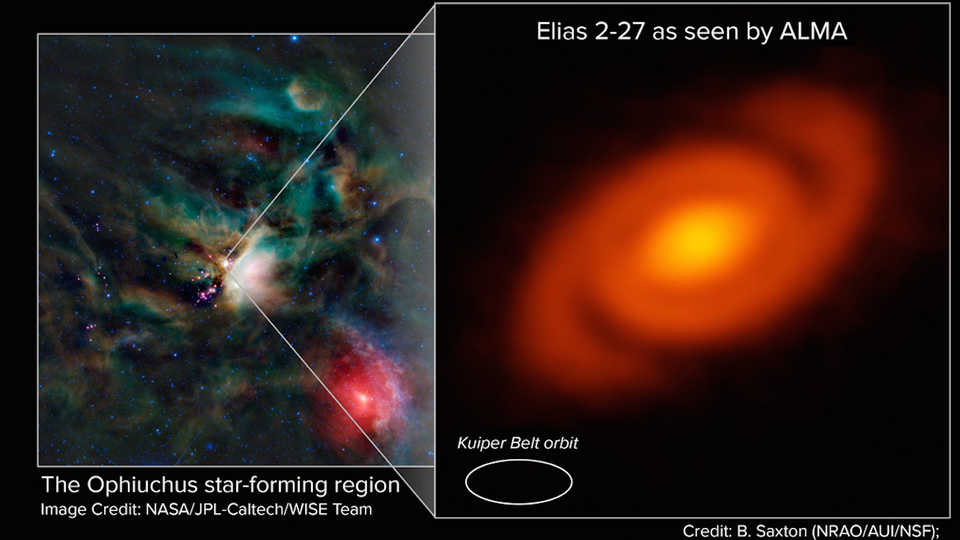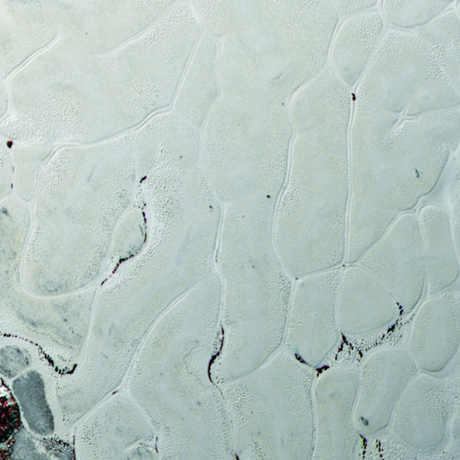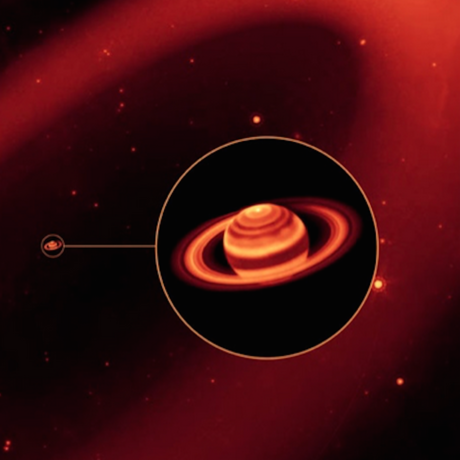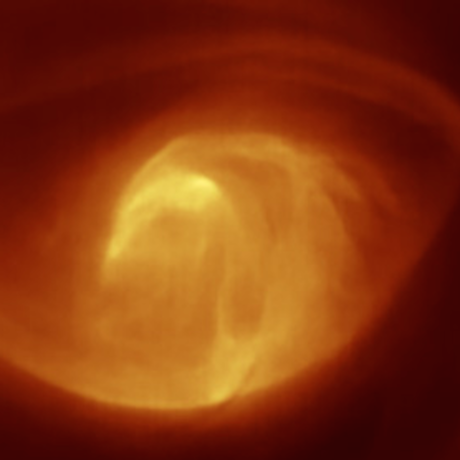Science News
Mercury, Rosetta, Europa, Pluto and a Spiral of Dust

Honey, I Shrunk the Planet
When Mariner 10 looped around the planet Mercury, passing it three times in 1974 and 1975, it made the first-ever close observations of the nearest planet to the Sun and mapped about 45 percent of the tiny world’s moonlike, crater-pockedsurface. The largest structure Mariner observed was the 1,300-kilometer (800-mile) diameter Caloris Basin, which is the result of an asteroid impact. Shock waves from the Caloris impact focused at the antipodal point on the opposite side of the planet, creating jumbled chaotic terrain. Mariner 10 also sent back images of lobate scarps—long, sinuous wrinkles in the crust, some of which measured hundreds of kilometers from end to end. These are thought to have resulted from shrinkage of the planet as it cooled billions of years ago and are often compared to what wrinkles the skin of a drying, shriveling apple.
The next time a spacecraft visited Mercury wasn’t until more than three decades later, when MESSENGER settled into orbit in 2011. When MESSENGER was launched in 2004, Mercury was recognized as the second-smallest planet in the Solar System, bigger than only Pluto. By the time it arrived in 2011, the International Astronomical Union had placed Pluto in the new category of dwarf planet, making Mercury the smallest of the planets. Now, data from the last 18 months of MESSENGER’s mission (before it deorbited and crashed to the planet’s surface) has revealed that Mercury really has become smaller… literally.
And it may still be shrinking.
As MESSENGER’s orbital altitude decreased, it took images at progressively higher resolutions, revealing smaller, previously unseen fault scarps which are less than ten kilometers (six miles) in length, which is several orders of magnitude smaller than the larger lobate scarps imaged by Mariner 10. These are young enough to cut across older impact craters and not themselves be rapidly obliterated by subsequent impacts. This suggests an age of no more than about 50 million years—geologically speaking, that’s young enough for the scientists to conclude that contraction and related faulting activity are still occurring now. Says Jim Green, Director of NASA’s Planetary Science Division, “For years, scientists believed that Mercury’s tectonic activity was in the distant past. It’s exciting to consider that this small planet—not much larger than Earth’s moon—is active even today.” –Bing Quock
Rosetta’s Farewell
Don’t be sad for Rosetta. Even though the European Space Agency (ESA) made the spacecraft quite human-like in its cartoon videos, her (ESA’s moniker, not mine) mission came to an abrupt but inevitable end early this morning when the craft impacted its comet subject, 67P/Churyumov-Gerasimenko(you can call it “67P” or “Churi” for short).
But the event was cause for joy, not mourning, says Johann-Dietrich Wörner, ESA’s Director General. “Today we celebrate the success of a game-changing mission, one that has surpassed all our dreams and expectations, and one that continues ESA’s legacy of ‘firsts’ at comets.”
Launched in 2004, Rosetta arrived at 67P in August of 2014 and ever since has sent back remarkable data. Some of the most important results are linked to the gases streaming from the comet’s nucleus, including the discovery of molecular oxygen and nitrogen, and water with a different “flavor” to that in Earth’s oceans. Together, these results point to the comet being born in a very cold region of the protoplanetary nebula when the Solar System was still forming more than 4.5 billion years ago.
And while it now seems that comets may not have delivered as much of Earth’s water as previously thought, another much anticipated question was whether they could have brought ingredients regarded as crucial for the origin of life. Rosetta didn’t disappoint, detecting the element phosphorus (a key component of DNA and cell membranes) and the amino acid glycine (commonly found in proteins). Numerous organic compounds were also detected by Rosetta from orbit—and by the short-lived Philae lander, in situ on the surface of the rubber-ducky shaped comet.
Rosetta worked until the very end of her mission. The descent gave her the opportunity to study the comet’s gas, dust, and plasma environment very close to surface, as well as take very high-resolution images. Her final image was taken a mere 20 meters (65 feet) from the surface.
Rosetta’s time may be over, but her data lives on, with more to discover r from the mission. “Inevitably, we now have new mysteries to solve,” says project scientist (and controversial shirt- wearer) Matt Taylor. “The comet hasn’t given up all of its secrets yet, and there are sure to be many surprises hidden in this incredible archive. So don’t go anywhere yet—we’re only just beginning.” –Molly Michelson
Thar She Blows?
On Monday, NASA announced that astronomers using the Hubble Space Telescope had confirmed the existence of towering plumes of salty water gushing through the crust of Jupiter's moon, Europa.
An earlier claim of a plume sighting was made in 2013 by a team led by Lorenz Roth of the Southwestern Research Institute (SwRI), but could not be confirmed. Then, in 2014, during a series of observations attempting to determine whether Europa has a thin atmosphere, a team under William Sparks of the Space Telescope Science Institute (STScI) watched the moon cross in front of the disk of Jupiter ten times. On three of those passes, signs of what appear to be plumes being ejected from the southern hemisphere reaching an altitude of 200 kilometers (125 miles) were detected. The STScI team’s observations appear to be the confirmation that the SwRI group and other scientist were waiting for, although Sparks is careful to say only that his data provide evidence that the plumes may exist—not that they provide definitive proof. The research paper relating to this work was published in this week's issue of The Astrophysical Journal.
But what does it mean?
An ocean beneath the icy surface of the Jovian satellite has long been suspected to exist, based on 1979 images from the two Voyager spacecraft that revealed the billiard ball-smoothness of Europa’s surface, indicating resurfacing—perhaps by water—in the geologically recent past. This was bolstered by detection of a weak magnetic field around Europa by NASA’s Galileo spacecraft, which orbited Jupiter from 1995 to 2003. This field is thought to be produced as Europa moves through Jupiter’s powerful magnetosphere, acquiring a field of its own—a process called induction. According to what physicists and chemists tell us about how induction works and what it would take to produce a magnetic field of the strength measured at Europa, planetary scientists deduce that there’s a global body of salt water below Europa’s surface, extending to a depth of perhaps 100 kilometers (60 miles).
In the search for life beyond Earth, Europa is becoming one of the most enticing places in the Solar System to look because of the amounts of water that scientists think exist beneath the surface, since water is a key ingredient for life. Again, we’re not talking the seasonal, here-and-there trickles and maybe-wet-spots that have been observed on present-day Mars, but perhaps a global ocean 100 kilometers (60 miles) deep! By comparison, the bottom of the Mariana Trench—the deepest point in Earth’s oceans—is about 10 kilometers (seven miles) deep. If the depth of Europa’s ocean is uniform, then that little moon would have more water than Earth itself does.
Scientists would love the opportunity to get to the water to study its life-supporting (or life bearing) potential. First, they have to figure out how to get through the surface ice, and designers have been considering combinations of heaters and drills to penetrate the frozen layer, which may be several kilometers thick, and current technology limits the depth that a Europa-bound drill can go to about 10 meters (33 feet).
Wouldn't it be great if there were places where the water is just gushing up from below so we wouldn't have to work so hard to… oh, wait.
NASA is already developing robotic missions to Europa—it’s actually written into law that an orbiter will launch no later than 2022 and a lander no later than 2024. Likewise, NASA’s European counterpart, ESA, is working on the Jupiter Icy Moons Explorer (JUICE), set for launch in 2022. —Bing Quock
Water beneath Pluto’s surface
Speaking of otherworldly oceans, evidence is building that Pluto may have a liquid ocean hiding just beneath its surface, possibly as large as 100 kilometers (60 miles) deep. Early results from the New Horizons flyby of Pluto last year revealed huge planes of ice lying on select regions of the dwarf planet. These ice fields show a suspicious lack of cratering which suggests these features were recently formed, roughly in the last ten million years, a totally unexpected result hinting that liquid water could be possible, though hard to imagine so far out from the warmth of the Sun. One of these regions, Sputnik Planum, is of particular interest.
Sputnik Plaum is a large icy plane that makes up the western region of Pluto’s heart-shaped feature, lying on the opposite side of the dwarf planet from its largest moon, Charon. It’s suspected the planes formed when a large impact blasted away a portion of Pluto’s surface; the intensity of the event would then have triggered a rebound that pulled material up from deeper within Pluto to fill in the new gap. The problem with this explanation is these “filled-in” impact sites are generally less dense and have a lower overall gravity, but Sputnik Planum’s alignment with Charon suggests it actually has higher gravity than the surrounding surface.
Pluto and Charon are tidally locked to each other, meaning small changes over time have perfectly matched their spins to their rotation such that they always have the same face turned towards one another. During this locking process, areas of high mass are torqued back and forth repeatedly, and once the system reaches an equilibrium, they will eventually settle along the same axis as the now tidally locked faces of the bodies. Researchers expect that this is precisely the reason Sputnik Planum lies along the Pluto-Charon axis, but are not exactly sure what lead to this heightened mass.
One of the ideas proposed is that the material dredged up from the impact was liquid supplied by a subsurface reservoir, something malleable enough to fill the entire impact crater—but relatively dense compared to the surrounding ice. A research team at Brown University led by planetary scientist Brandon Johnson ran simulations to recreate the impact event and following formation of Sputnik Planum. The simulations found that for an impact large enough to form the planum, a liquid water ocean roughly 100 kilometers (60 miles) deep would have to exist down below the surface to account for the resulting mass excess. Not only that, but the ocean would also need a salinity of roughly 30 percent to account for the density needed—roughly 10 times saltier than Earth’s ocean water, or closely comparable to the Dead Sea.
These results add Pluto to the ever-expanding list of worlds beyond Earth that show signs of liquid water (albeit subsurface liquid water) and contribute to a growing body of evidence suggesting that oceans like our own could be plentiful all over our galaxy and beyond. As we learn more about these extra-terrestrial water sources, the big questions we’re primed to tackle are beginning to shift from “How common is water like we find on Earth in the rest of the cosmos?” to “How common is life like we find in Earth’s water throughout the rest of the cosmos?”
This study was one of the first forays into exploring the idea of liquid water on Pluto, likely with many more to follow. As New Horizons wraps up its 16-month data download back to Earth, we will have even more high resolution data for Johnson’s team and others to examine, undoubtedly unveiling even more surprises and unexpected discoveries for Pluto and the rest of the outer Solar System. –Aaron White
Elias Spiral
As Josh Roberts wrote about last week (under the heading “Enhancing Hubble’s Deepest View”), the Atacama Large Millimeter (and submillimeter) Array (ALMA) has empowered astronomers with an extraordinarily sharp view of the cosmos. These observations impact our understanding of many, many astrophysical happenings…
Last week, we highlighted ALMA contributions to deciphering phenomena very far from home, very early in the history of the Universe. This week’s ALMA announcement concerns something much closer to home, both physically and metaphorically—a newborn planetary system.
The ALMA image clearly shows a spiral of dust encircling the young star Elias 2-27. Aside from being a nifty picture, the image confirms decades of computational simulations of planetary systems in the process of forming! (Check out our video on that topic, BTW.) And it confirms that there’s a lot of stuff (okay, an astronomer should say mass) from which to form planets.
ALMA has already revealed a lot about the birth of planets around young stars, but this new observation shows a previously unseen spiral structure—something predicted by computer models but not seen till now. We’ve seen spiral structures (this one, for example) likely caused by planets that have already formed inside a disk (think of the spirals as material flowing in the wake of the planets), but Elias 2-27 is so young that planets haven’t yet had a chance to take shape…
Thus, the spiral structure must form from the mass of the disk itself, which means there must be a lot of stuff (sorry, mass) in the disk in order to create the spiral density waves ALMA observed. We see density waves in spiral galaxies, and they show up (as previously mentioned) in computer simulations of planetary disks, but again, we haven’t previously observed them.
Basically, this means there’s a lot of stuff in the disk from which to form planets!
And on a personal note, interestingly, this result features the work of Andrea Isella’s research group—from Rice University, my graduate school ALMA mater! [Insert knee slap here.] –Ryan Wyatt


